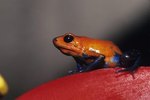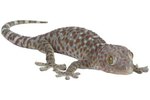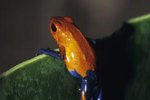
Geckos' tongues are like Swiss Army knives in their mouths. In many ways the gecko's tongue is used like a frog's, but it also has its own specialties. Geckos use their tongues to hunt, eat, learn about their environment and groom themselves.
How Geckos and Frogs Hunt
Gecko tongues are long, flexible and elastic. Both gecko and frog tongues are made of long, flexible muscle fibers that when elongated push the tongue out of the mouth and when contracted bring it back in. It is the stickiness at the end of the tongue that grabs prey. This along with the speed with which the tongue moves makes almost every attack a sure win for the gecko or frog. A mucous secreted at the moment the tongue makes contact with the prey is what gives the tongue such strong grabbing power. Geckos don't always use their tongues to grab prey. Sometimes they simply snap their mouths at the intended victim and catch it in their jaws.
How Geckos Taste
Geckos have a pair of Jacobson's organs in the roof of their mouths. The Jacobson's organ is a receptor filled with nerve cells that communicate with the brain. Geckos extend their tongues and "taste" their environment to gain information about it, much like a snake flicking its tongue in and out -- snakes also have Jacobson's organs. The particles captured on the tongue are then transmitted to the Jacobson's organs, where data is collected and interpreted by the brain. For instance, a "taste" of the surroundings might tell a gecko that a potential mate or meal is in the vicinity. A breeding partner would release pheromones that the tasting gecko could perceive. However, most of the tasting a gecko does is to determine whether an object is suitable for eating.
Gecko Grooming
In addition to catching food and sensing the environment, the gecko tongue is also used frequently for grooming. Gecko tongues are long enough to reach the eyes and nose for cleaning. Some gecko species don't have eyelids; instead they have a clear scale called a brille -- a permanent lens that protects the eye. The tongue is used to clean the brille. Other species have eyelids but still use the tongue to remove small particles and debris.
How Frog Tongues Work
Researchers are fascinated with the unusual qualities of frog tongues -- their incredible strength, speed and stretchiness are unique in the animal kingdom. Scientists have determined that a system of perpendicular muscles within the tongue make possible the feats this organ performs. Also, frogs' tongues are attached to the front of their mouths, rather than in the back of the mouth near the throat like most vertebrates. The way the frog projects its tongue is different from animals like geckos, snakes or anteaters. While these animals can control the extent to which the tongue is extended, frogs unfurl their tongues from their mouths, launching it almost like a catapult toward the intended victim. The tip of the tongue rests at the back of the throat when the mouth is closed, then flips out of the mouth to grab froggy's dinner.
References
- Google Books: Geckos: A Complete Pet Owner's Manual, p. 13, 17; Bartlett, Richard D.; Bartlett, Patricia Pope
- Google Books: On the Anatomy of Vertebrates -- Fishes and Reptiles. p. 438. Owen, Richard.
- Google Books: Eyewitness to Science. p. 397. Carey, John.
- New York Times: Flick of a Frog's Tongue: Finding the Secret of Its Speed
- Evolution, Vol. 30, No. 4: Functional Aspects of the Evolution of Frog Tongues. p. 718. Regal, Philip J., Gans, Carl.
- NY Times Science: Frogs' Tongues
Resources
Photo Credits
-
Jupiterimages/Photos.com/Getty Images
Writer Bio
Madeline Masters works as a dog walker and professional writer. In the past she has worked as a fitness columnist, fundraising copywriter and news reporter. Masters won two Pennsylvania Newspaper Association Awards in 2009. She graduated from Elizabethtown College with a Bachelor of Arts in English.




